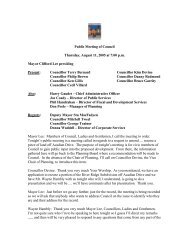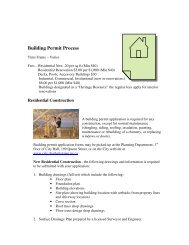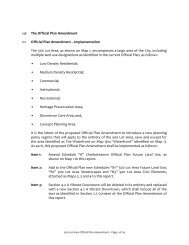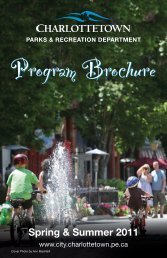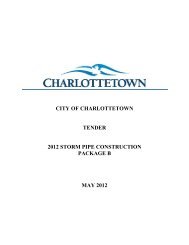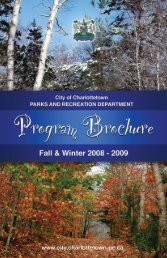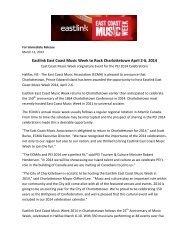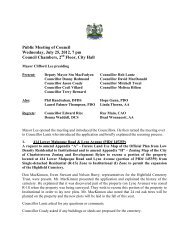Victoria_Park_Re port Final.pdf - City of Charlottetown
Victoria_Park_Re port Final.pdf - City of Charlottetown
Victoria_Park_Re port Final.pdf - City of Charlottetown
Create successful ePaper yourself
Turn your PDF publications into a flip-book with our unique Google optimized e-Paper software.
VICTORIA PARK COMPREHENSIVE MASTER PLAN<br />
<strong>Final</strong> <strong>Re</strong><strong>port</strong> • June 2013<br />
Move Seaward<br />
The futility <strong>of</strong> trying to predict future scenarios where there is a large human influence<br />
is apparent. Even future climate is a function <strong>of</strong> what humans choose to make <strong>of</strong> it. In<br />
some cases - where new areas are needed for new economic or ecological development<br />
- a move seaward strategy can be adopted.<br />
There is an obvious downside to this strategy. Coastal erosion is already widespread,<br />
and there are many coasts where exceptional high tides or storm surges result in<br />
encroachment on the shore, affecting human activity. If the sea rises, many coasts<br />
that are developed with infrastructure along or close to the shoreline will be unable to<br />
accommodate erosion. They will experience a so-called “coastal squeeze” where the<br />
exposed zones that would normally retreat landwards encounter solid structures and are<br />
squeezed out. Wetlands, salt marshes, mangroves and adjacent fresh water wetlands are<br />
particularly likely to suffer from this squeeze.<br />
An upside to the strategy is that moving seaward (and upward) can create land <strong>of</strong> high<br />
value which can bring the investment required to cope with climate change.<br />
Limited Intervention<br />
Limited intervention is an action taken where decisions are made that only solve the<br />
problem to some extent, usually in areas <strong>of</strong> low economic significance. Measures taken<br />
using limited intervention <strong>of</strong>ten encourage the succession <strong>of</strong> salt marshes and sand<br />
dunes. This will normally result in the land behind being more sufficiently protected, as<br />
wave energy will be dissipated by the accumulated sediment and additional vegetation<br />
residing in the newly formed habitat.<br />
Seawall Best Practice<br />
Seawalls are probably the second most traditional method used in coastal<br />
management. Seawalls may be constructed from a variety <strong>of</strong> materials, including<br />
reinforced concrete, boulders, steel, or gabions. Additional seawall construction<br />
materials may include an earthen bank used to create a dike construction. Generally<br />
seawalls can be a successful way to control coastal erosion, but only if they are<br />
constructed well and out <strong>of</strong> materials which can withstand the force <strong>of</strong> ongoing wave<br />
energy. Seawalls can <strong>of</strong>fer a more long-term solution, additionally providing recreation<br />
op<strong>port</strong>unities and protection from extreme events as well as everyday erosion.<br />
A cost benefit approach is an effective way to determine whether a seawall is<br />
appropriate and whether the benefits are worth the expense. Besides controlling<br />
erosion, consideration must be given to the effects <strong>of</strong> hardening a shoreline on natural<br />
coastal ecosystems and human property or activities. A seawall is a static feature<br />
which can conflict with the dynamic nature <strong>of</strong> the coast and impede the exchange <strong>of</strong><br />
sediment between land and sea. These factors must be considered in assessing the<br />
cost benefit ratio, which must be favorable in order to justify construction <strong>of</strong> a seawall.<br />
Advantages <strong>of</strong> Seawalls<br />
»»<br />
Long-term solution in comparison to s<strong>of</strong>t beach nourishment.<br />
»»<br />
Effectively minimizes loss <strong>of</strong> life in extreme events and damage to property caused by erosion.<br />
»»<br />
Can exist longer in high energy environments in comparison to ‘s<strong>of</strong>t’ engineering methods.<br />
»»<br />
Can be used for recreation and sightseeing.<br />
»»<br />
Forms a hard and strong coastal defence.<br />
In the case <strong>of</strong> <strong>Victoria</strong> <strong>Park</strong> the strategy that needs to be investigated is the hold the line<br />
option as the do nothing, managed realignment, or limited intervention will not work due<br />
to the value <strong>of</strong> the lands that are being protected or the purpose <strong>of</strong> the protection.<br />
20



